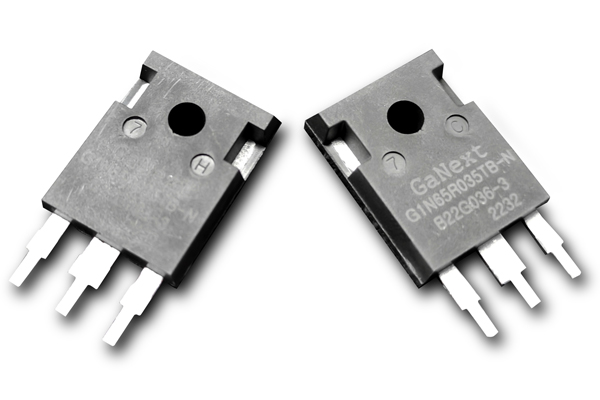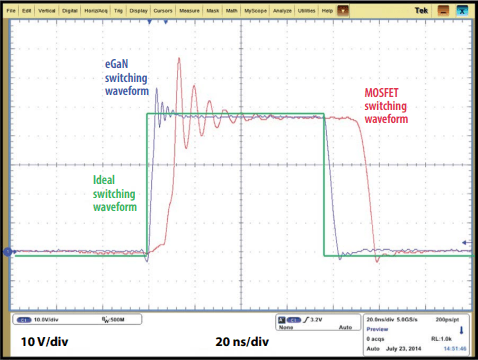Silicon MOSFETs have limitations that can affect their performance in audio applications. Some of these limitations include the following:
- High switching losses: When a MOSFET switches on or off, it experiences a brief period during which it dissipates significant amounts of power. These switching losses can lead to reduced efficiency and increased heat generation. In Class-D audio systems, high switching losses can result in lower output power and reduced overall system efficiency.
- Limited bandwidth: The switching performance of silicon MOSFETs limits the output stage switching frequency. This limitation can result in reduced efficiency and lower output power.
- Thermal limitations: Silicon MOSFETs can generate significant amounts of heat in high-power Class-D audio systems. To counter this limitation, many designers use bulky heat sinks, which add size, weight, and cost to the system.
- Gate drive limitations: Gate drive voltage must be supplied quickly and accurately to ensure efficient switching. In Class-D audio systems, gate drive limitations from slow gate turn-on can reduce efficiency and increase distortion.
Power electronics engineers are overcoming these limitations using alternative power devices such as Gallium Nitride (GaN) and Silicon Carbide (SiC). These devices offer advantages such as faster switching speeds, higher bandwidths, and improved thermal performance.
|
| |
Applications for GaN in Audio Power Amplification
GaN FETs and ICs are well-suited for audio applications requiring high performance, high efficiency, and high-power output. Some of the audio applications where GaN technology is particularly beneficial include:
- Stand-alone audio amplifiers: GaN is ideal for Class-D audio amplifiers because of its high switching speed, low on-resistance, and high breakdown voltage. These properties enable the design of high-power, high-fidelity amplifiers with excellent efficiency and reduced distortion.
- Active loudspeakers: GaN can be used in the power stages of active loudspeakers, including soundbar and wireless speakers, enabling the design of smaller, lighter, and more efficient systems with improved audio quality.
- High-power portable audio systems: GaN can be used in the power management circuitry of portable audio devices, enabling longer battery life and improved audio quality.
- Professional audio systems: GaN is well-suited for high-performance professional audio systems that require high-power output and high fidelity, such as concert sound systems, professional audio mixing consoles, recording studios, and broadcast facilities.
- Automotive audio systems: GaN can be used in the power stages of automotive audio systems, enabling higher output power and improved efficiency in a smaller form factor.
|
What is Gallium Nitride (GaN) Technology?
Gallium nitride (GaN) is a wide bandgap semiconductor that has demonstrated the capability to displace silicon in traditional power conversion applications, including DC-DC conversion, AC/DC conversion, motor drives, and audio amplifiers, to name just a few. With higher breakdown strength, faster switching speed, higher thermal conductivity, and lower on-resistance, power devices based on GaN significantly outperform silicon-based devices.
|
Understanding the Benefits of Gallium Nitride Audio Amplifiers
GaN FETs and ICs have several advantages over traditional Silicon MOSFETs, making them well-suited for use in high-quality, lower-cost Class-D audio amplifiers. Some of these advantages include the following:
- Faster switching speeds: GaN has higher electron mobility than silicon, allowing faster switching speeds than traditional silicon MOSFETs. This feature reduces switching losses and improves overall efficiency. Higher switching frequencies result in more precise control over the output waveform, resulting in lower distortion, higher fidelity, higher bandwidth, and better transient response.
- Lower on-resistance: GaN has a wider bandgap than silicon; thus, GaN FETs have significantly lower on-resistance and reduced conduction losses compared to traditional silicon MOSFETs, which reduces power losses and allows for higher output power. This results in more efficient amplifiers that require less cooling and can be built with smaller form factors.
- Reduced component count: The higher switching frequency of GaN results in designs requiring fewer and less expensive external components than traditional silicon designs, simplifying the amplifier design and reducing the overall cost.
- Lower distortion: GaN FETs have lower parasitic capacitance and inductance, which reduces distortion and improves overall fidelity.
- Smaller form factor: GaN devices can be made smaller than silicon devices with the same performance specifications. This advantage for GaN allows for smaller and more compact amplifier designs.
Overall, GaN devices offer improved performance, better efficiency, and higher fidelity than silicon devices for audio amplifier applications, especially those requiring high power output and high fidelity.
|
How are Audio Technology Companies Using GaN Technology in their Products
Several audio companies are currently using GaN technology in their amplifiers. Here are a few examples:
- Panasonic has developed a GaN-based audio amplifier technology and used it in the reintroduction of their high-end audiophile Technics brand. This technology can be used in various audio products, including car audio systems, home theater systems, and portable Bluetooth speakers.
- Innosonix replaced traditional silicon FETs with GAN FETs in their high-end Maxx series multi-channel power amplifier, reducing idle loss by 35% and increasing total power efficiency by 5%. The clean switching waveform of GaN leads to a nearly perfect switching voltage and, therefore, better linearity. This resulted in a reduction in harmonic distortion of almost 6dB and audibly improved audio quality.
- Syng selected GaN FETs for the power supply design of its high-fidelity wireless speaker. The power supply design is optimized using GaN to achieve optimal performance in a small space with minimal heat dissipation. The GaN design eliminated the need for a heatsink or fan cooling, resulting in a smaller, sleeker design.
|
| |
The Future of Gallium Nitride Audio Amplifiers
The future of GaN in the audio amplifier industry looks very promising. As GaN technology continues to evolve, it is expected to become more widely used in audio amplifiers due to its many advantages over traditional Silicon MOSFET technology.
Some of the critical areas where GaN is expected to make significant inroads in the audio amplifier industry include:
- Higher power density: GaN technology allows higher power output in a smaller form factor, making it ideal for high-power audio applications such as professional sound systems and car audio.
- Higher efficiency: GaN-based amplifiers offer higher efficiency than traditional Silicon MOSFET-based amplifiers. This means that GaN-based amplifiers can deliver the same amount of power with less heat dissipation, which is especially important for portable and automotive audio systems.
- Improved audio quality: GaN-based amplifiers offer lower distortion and noise than traditional amplifiers. This means that audio signals can be amplified with greater fidelity, improving audio quality.
- Smaller size and weight: GaN-based amplifiers require fewer components than traditional amplifiers, resulting in smaller and lighter amplifier designs.
- Lower costs: As GaN technology continues to mature and become more widely available, the cost of GaN-based amplifiers is expected to decrease, making them more accessible to a broader range of audio applications.
As audio technology companies continue to explore the potential of GaN-based amplifiers, we can expect to see more innovative audio products incorporating this technology in future years.
|













